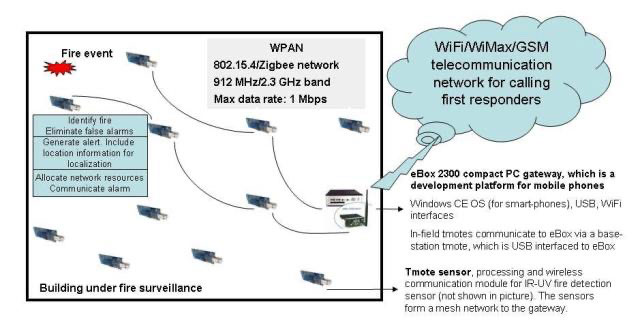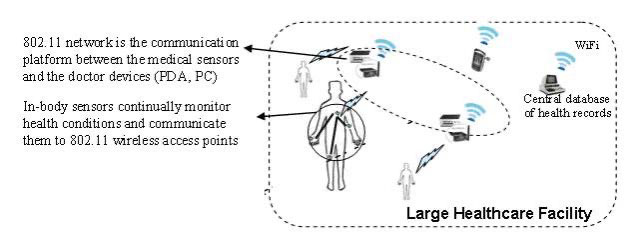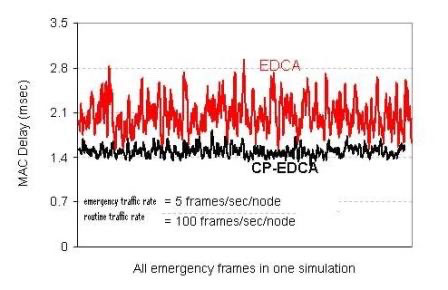QoS Enhancements for Emergency Response Networks
Motivation
The foray of wireless networks into time-sensitive applications, such as remote healthcare, fire tracking and industrial automation, demands support for emergency services and guaranteed Quality of Service (QoS). Wireless Sensor Networks (WSNs) also find extensive applications in remote disaster and health monitoring, where traffic prioritization is extremely essential for timely dissemination of critical information to the first responders. The IEEE 802.11e QoS technology is an attractive option for distributed emergency networking; however, the current differentiated services framework needs crucial design enhancements. Particularly, the medium access privileges for emergency traffic need to be deterministic (exclusive) rather than probabilistic guarantees. The main goal of this research area is to improve the current wireless QoS methods from providing probabilistic prioritization to deterministic guarantees for expanding their applicability to emergency response networks.
Applications of Interest


Challenges and Focus
Medium Access Control (MAC) is one of the the key functionalities to achieve efficient network QoS. DiffServ, IEEE standards 802.16e, 802.11e define traffic priorities and algorithms for scheduling medium access so that they can achieve differentiated services demanded by the application. Our aim is to answer the research question: Can we develop a QoS MAC that can provide deterministic services/guaranteed QoS bounds, so that it can be reliably applied for emergency reporting, under all network constraints such as channel errors, heavy load?
Achieving guaranteed services using Coordinated MAC schemes (GTS in 802.15.4 standards) is highly efficient. However, random MAC schemes are more suited for dynamic distributed wireless/sensor networks. Random MAC methods are flexible to changes in network/channel state (frequent in ad-hoc nets), since channel access is open and not pre-scheduled, incur low management overhead and scale inherently with the network size. But there are several challenges. We address
- Achieving determinitic QoS performance during random channel access.
- Resilience to channel errors, since rated channel time allocation is merely not enough if the channel has bursty errors during the transmission opportunity of emergency traffic.
- Priority aging techniques to balance unfairness problems in QoS MAC schemes.
In-channel Service Preemptions
We are currently exploring an in-channel service preemption methodology, during random channel access, where emergency traffic will have the privileges to preempt the services of other routine traffic in the network for guaranteeing the lowest possible channel access latencies. We designed the preemption concept within the 802.11e EDCA framework, called CP-EDCA. The queuing analysis and ns-2 simulation evaluations demonstrate the importance of service preemptions for expanding the applicability of 802.11e standards to emergency reporting networks.
The performance results for emergency frames depict 50% uniform decrease in medium access delays, improved delay guarantees and insensitivity to routine traffic competition, when using our Channel Preemptive-EDCA (CP-EDCA) as compared to the standard EDCA, even during network overloads. The cost, however, is increased delays for routine traffic, which is acceptable during emergency services. We believe that the CP-EDCA concept will be a significant addition to the 802.11e standards, due to the proliferation of time-critical applications of wireless networks.

Related Publications
- M. Balakrishnan, et al., Channel Preemptive EDCA for Emergency Medium Access in Wireless Net-works, IEEE Transactions on Wireless Communications. under review.
- M. Balakrishnan et al., In-channel Service Preemptions for Emergency Medium Access in Healthcare Sensor Networks IEEE MILCOM 2008, San Diego, November 2008
- D. Benhaddou, M. Balakrishnan, X. Yuan, Remote Healthcare Monitoring System Architecture using Sen-sor Networks, IEEE Region 5 Conference 2008.
- S. Bagga, X. Yuan, M. Balakrishnan, D. Benhaddou, DS-MAC for Wireless Medical Information Systems, EMBC 2008, Vancouver, Canada, August 2008.